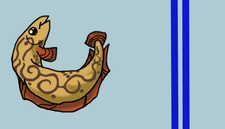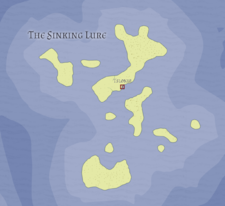Help:Nation
The Sinking Lure (TSL; officially The Serene Republic of The Sinking Lure) is a small, archipelagic nation in the northern Sea of Subculture. Situated between the much larger nations of Zeldafront and ZRPG, The Sinking Lure (TSL) consists of ten islands: three major provincial islands, six territorial islands, and one loosely-connected protectorate. The country's capital, Tslonia (se'loʊːniə; suh-low-nee-a), is located along the southeastern coast of Lanayru Island, and is also the country's largest city. Each province has a regional capital, and each territory has a village or small town that is capable of interfacing with the larger country around it.
Overview
The Sinking Lure is notable for its simple architectural style and relative lack of modern technologies. Outside of the major population centres, most Lureans live as farmers, raising crops and wildlife among the idyllic environments the archipelago boasts. The population is peaceful, almost pacifistic, in nature and generally uninterested in the happenings of the world outside of their own borders. As such, the islands have become unofficial nature sanctuaries, with a majority of the forests, lakes, and rivers untouched by the pollution of modern life.
The Separation War consisted of the two major powers within the country coming to a disagreement over policy, and the Wisdom of the time leaving the Citadel and retreating to Nohansen. After eighteen months, the major population centres were simultaneously destroyed and a majority of the population was killed. It is assumed to be the work of high-level forbidden magic, but very few people were left to fight back or investigate the aftermath. During the ensuing chaos, the Courage of the time left the country to work as a politician within the nearby Empire of ZRPG, leaving Power alone with the handful of survivors to find a way to rebuild. Currently, the borders are closed and news from inside the archipelago is almost unheard of in the wider internet.
Territory
Lanayru
Lanayru, the largest of the islands, is the seat of power in The Sinking Lure. The capital city hosts 75% of the country's population, including representatives from the other islands, and is centred around the Citadel, where the Tribunal is housed. The rest of the province consists of prairie in the southwest, which becomes gradually more hilly in the centre of the country, and eventually peaks into the island's lone mountain. The regional capital for Lanayru is Nohansen, a small city among the hills of the northeastern portion of the island.
Eldin
Eldin is much more mountainous, and is centred around a dormant volcano. The soil is rich, and the few areas where the terrain allows for it are dotted with farmland, while the regional capital, Dunohi, is situated at the lone pass between the northern and southern portions of the country.
Faron
Faron, the final province, is a rich and verdant forest. Massive redwood and sequoia trees dot the landscape, and most of the country's wood products come from the lively forestry business on this island. Practicing sustainable woodcutting practices, the people of Faron Province ensure that the forest will remain essentially untouched, while new trees are able to cycle through their own lifespans. The regional capital, Fygores, is a small, shady village along the northwestern coastline, across from Tslonia, and exists mostly as a trading port with the rest of the country.
Ordonia
Ordonia, the protectorate, has a majority of the country's farmland, and is the furthest island to the south, the only one within the temperate zone. Its regional capital is Ordon Village, a trading port on the northern tip of the island.
Territories
The territories, Twili, Aris, Peak, Terminae, Naydrae, and Dinraal, dot the spaces around and between the major provinces. Peak, Dinraal, and Naydrae are mountainous and are used primarily for mining metals. Aris is only barely large enough to be classified as an island, but is growing due to the active volcano on the island. It currently has no soil and cannot support crops or life. Twili has a small fishing outpost, being the most removed territory, and is the source of a majority of deep-water seafood in The Sinking Lure. Terminae is overgrown with jungle, and has been abandoned since the original outpost on the island was overrun by predatory wildlife and several dozen Lureans were killed.
Government
The Sinking Lure is traditionally ruled by a Tribunal of mages, one from each province, and a small legislative branch of representatives from each island to petition for local needs. Like all powerful mages in TSL, the Tribunal go by pseudonyms to protect their true names, and operate within various seats. The representative of Eldin inhabits the seat of Power, while the representative of Lanayru holds the seat of Wisdom and the representative of Faron holds the seat of Courage. Each mage ostensibly has equal standing and power within the realm, though traditionally Power and Wisdom have traded off who guides the direction of the group's mandates. Currently, there is only one remaining member of the Tribunal, Siv (Seat of Power), who held the seat during The Separation War and ensuing destruction. Judicial decisions go through local magistrates, with a high court existing within Tslonia, based off of the Almighty Legal Page, a document that coincided with the founding document of the country, What Have We Learned.
| |||||||||||||||||
 Part of a series of tutorials for the Refuge Wiki | |||||||||||||||||||
Tutorial Navigation
| |||||||||||||||||||
|---|---|---|---|---|---|---|---|---|---|---|---|---|---|---|---|---|---|---|---|
| Demo Pages
| |||||||||||||||||||
Nation Template
Templates within MediaWiki function by calling on elements defined in the CSS file, in the JavaScript file, or just by using raw html. Templates exist to allow users to navigate this code without rewriting it countless times or by using elements that are too complicated to easily be understood. The Template:Infobox functions by using elements defined in the CSS file, while the Template:Navbox calls on the table forming mechanics of CSS. Since they're both templates within this wiki, knowledge about how either system works is unnecessary to fill one out.
This page will show you have to fill out the nation template for use on your pages. See Help:Templates for help on creating your own template from scratch.
The Info Box
Infoboxes are panels that are automatically placed on the side of whatever article that they are placed on in order to provide a brief and easy to read summary of the topic at hand. The templates Template:Character, Template:Nation, and Template:Item are all specialised templates that are derived from Template:Infobox so that they're easier to use and better convey the topic at hand. All three of these function in the same way, which means that they can be constructed in the same way once you get to know how the infobox is put together. For demonstration purposes, we'll work on filling out the nation template, which is demonstrated above. The complete interface for this template will be at the bottom of this page.
We can begin by navigating to the page that we want to write the article. If this page doesn't exist already, type the name of the article into the wiki search bar. If there is no article by that name, you will be asked if you would like to write one. In this example, we'll just practice filling out the template that's at the top of this page.
The Template and Name
Start by invoking the template:
{{nation
The {{ symbols mean you are starting the template. We can close it off with }} after we're done putting in our data.
The first entry we can add is |name =. This is usually the name that will display over the infobox in bold letters. Usually, this is the title of the article because it's the name of the subject that the article is about. But if ever you have the need to have the infobox be a title that's different, you can do so by writing something else here.
Each instance of | indicates an input slot that was designated in the template we're working in. So "name|" is registered as an input in Template:Nation that means we can put something there.
{{nation
|name = The Sinking Lure
Subheader
The next section is the subheader. In traditional articles, this is used to write the name of the nation or region in the language that's native to it. In this example, Tslonia's primary language is Hylian, which is not a character set recognised by unicode, and it's secondary language is English (the same as the title), so we'll omit this section.
Image
We can add an image as the next section of the nation's display. This image can be a picture that represents the subject matter or a map of where it is located in the world. In this example, we're going to use File:TSLFlag.png. We'll need to specify how we want this image to render. If no specification is added, the image will be rendered at its full resolution, in this case that would be six hundred pixels. Add this specification by attaching a vertical pipe and the number of pixels wide you would like it to be. Try not to disturb the natural shape of the template. The recommended setting is 225px, because that size is neat-o.
{{nation
|name = The Sinking Lure
|image = [[File:TSLFlag.png|border|225px]]
Notice how there is abundant whitespace in between the variables and what we've input for them. When the code is run, all of this is reduced to a single white space. Therefore, you may use as many spaces as you would like to organise your template and make it easier for you and everyone else to read.
Caption
In this section, we can add a caption to the picture above by using the |caption = input. This should describe the picture or the map in some capacity. Below this caption, there is a second image input available with the input |image2 = . Since the first image that we're using is the national flag for The Sinking Lure, this seems like a good place to include the map of where it is located. There is no secondary caption available for the second image, but if you elect to use a map, the image more or less speaks for itself.
{{nation
|name = The Sinking Lure
|image = [[File:TSLFlag.png|border|225px]]
|caption = The National Flag, featuring the Hylian Loach, known for frolicking in the nation's lush forests.
|image2 = [[File:TSLMap.png|border|225px]]
Region
All locations that use this template have to be described with the region that they are located in. Even if the subject has been transported to a void dimension, "Void" has to be an input here. The region section of data describes the physical traits about the article and you can use the following inputs:
|region - Where the subject is located. This displays inside the data section's header and must be filled out.
|capital - The name of the place the governs this subject. If the subject of the article is an uninhabited location, it can be omitted.
|language - The primary language spoken in the subject. If multiple languages are spoken, they can be all listed here anyway.
|demonym - The name of how the residence of the place are called. For example, the demonym of Refuge Isle is "Refugi".
For this example, we'll be using the following sections:
{{nation
|name = The Sinking Lure
|image = [[File:TSLFlag.png|border|225px]]
|caption = The National Flag, featuring the Hylian Loach, known for frolicking in the nation's lush forests.
|image2 = [[File:TSLMap.png|border|225px]]
|region = Sea of Subculture
|capital = Tslonia
|language = Ancient Hylian <br> English
|demonym = Lurean
Government
The government data section deals with political facts about how the subject is governed. The following inputs are available here:
|gov - The style of government that the subject has, such as "Constitutional Monarchy".
|office - The title of the leader of the subject, such as "Arch-Administrator".
|leader - The name of the leader, such as "Alexis Cat".
|legtype - The type of legislature that the subject has, such as "Parliament".
|legname - The name of the legislative body, such as "House of Commons".
|court - The name of the court system, such as "Civil Law".
For The Sinking Lure, we'll do our best to convert these sections to our needs, because templates have the capacity to be used for things that they weren't strictly designed for.
{{nation
|name = The Sinking Lure
|image = [[File:TSLFlag.png|border|225px]]
|caption = The National Flag, featuring the Hylian Loach, known for frolicking in the nation's lush forests.
|image2 = [[File:TSLMap.png|border|225px]]
|region = Sea of Subculture
|capital = Tslonia
|language = Ancient Hylian <br> English
|demonym = Lurean
|gov = Tribunal
|office = Power
|leader = Siv
|court = Almighty Legal Page
Demographics
The demographics section deals with information about the population and how they behave. The following inpus are available here:
|pop - The population of the subject.
|currency - The name of the official or de facto currency used by the subject and symbol if applicable.
|religion - The national or majority religion for the subject region.
|abb - The shorthand abbreviation for the subject, if applicable.
In this section, we'll add the following content:
{{nation
|name = The Sinking Lure
|image = [[File:TSLFlag.png|border|225px]]
|caption = The National Flag, featuring the Hylian Loach, known for frolicking in the nation's lush forests.
|image2 = [[File:TSLMap.png|border|225px]]
|region = Sea of Subculture
|capital = Tslonia
|language = Ancient Hylian <br> English
|demonym = Lurean
|gov = Tribunal
|office = Power
|leader = Siv
|court = Almighty Legal Page
|pop = 25
|currency = Rupees
|religion = Hylia, Three Golden Goddesses
|abb = TSL
We can use the |notes = section to write in any content that doesn't fit anywhere else. For this page, there is no such content, so well finish up the template by closing it out with }}
Base Template
The complete interface for this template is below. Copy this template to your article's page and feel free to delete or leave the parts blank that you do not need to use.
{{nation
|name =
|sub =
|image =
|caption =
|image2 =
|region =
|capital =
|language =
|demonym =
|gov =
|office =
|leader =
|legtype =
|legname =
|court =
|pop =
|currency =
|religion =
|abb =
|notes =
}}




